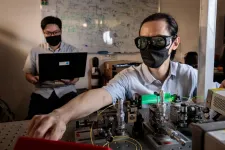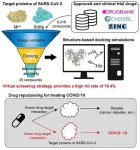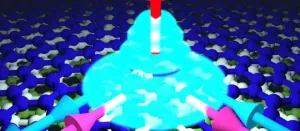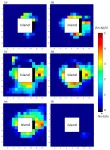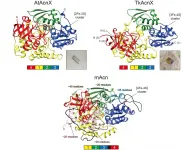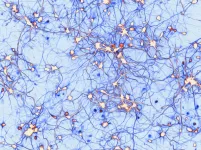(Press-News.org) Quantum key distribution (QKD) is a method for secure communication that uses quantum mechanics to encrypt information. While the security of QKD is unbreakable in principle, if it is incorrectly implemented, vital information could still be stolen by attackers. These are known as side-channel attacks, where the attackers exploit weaknesses in the setup of the information system to eavesdrop on the exchange of secret keys.
Researchers from the National University of Singapore (NUS) have developed two methods, one theoretical and one experimental, to ensure that QKD communications cannot be attacked in this way. The first is an ultra-secure cryptography protocol that can be deployed in any communication network that needs long-term security. The second is a first-of-its-kind device that defends QKD systems against bright light pulse attacks by creating a power threshold.
"Rapid advances in quantum computing and algorithmic research mean we can no longer take today's toughest security software for granted. Our two new approaches hold promise to ensuring that the information systems which we use for banking, health and other critical infrastructure and data storage can hold up any potential future attacks," said Assistant Professor Charles Lim, from the NUS Department of Electrical and Computer Engineering and Centre for Quantum Technologies, who led the two research projects.
Future-proof quantum communication protocol
Typically, in QKD, two measurement settings are used - one to generate the key and the other to test the integrity of the channel. In a paper published in the journal Nature Communications on 17 May 2021, the NUS team showed that with their new protocol, users can independently test the other party's encryption device by generating a secret key from two randomly chosen key generation settings instead of one. The researchers demonstrated that introducing an extra set of key-generating measurement for the users makes it harder for the eavesdropper to steal information.
"It's a simple variation of the original protocol that started this field, but it can only be tackled now thanks to significant developments in mathematical tools," said Professor Valerio Scarani, who was one of the inventors of this type of method and is a co-author of the paper. He is from the NUS Department of Physics and Centre for Quantum Technologies.
Compared to the original 'device-independent' QKD protocol, the new protocol is easier to set up, and is more tolerant to noise and loss. It also gives users the highest level of security allowable by quantum communications and empowers them to independently verify their own key generation devices.
With the team's setup, all information systems built with 'device-independent' QKD would be free from misconfiguration and mis-implementation. "Our method allows data to be safe against attackers even if they have unlimited quantum computing power. This approach could lead to a truly secure information system, eliminating all side-channel attacks and allowing end-users to monitor its implementation security easily and with confidence," explained Asst Prof Lim.
A first-of-its-kind quantum power limiter device
Quantum cryptography, in practice, uses optical pulses with very low light intensity to exchange data over untrusted networks. Leveraging quantum effects can securely distribute secret keys, generate truly random numbers, and even create banknotes that are mathematically unforgeable.
However, experiments have shown that it is possible to inject bright light pulses into the quantum cryptosystem to break its security. This side-channel attack strategy exploits the way injected bright light is reflected to the outside environment, to reveal the secrets being kept in the quantum cryptosystem.
In a new paper published in PRX Quantum on 7 July 2021, the NUS researchers reported their development of the first optical device to address the issue. It is based on thermo-optical defocusing effects to limit the energy of the incoming light. The researchers use the fact that the energy of the bright light changes the refractive index of the transparent plastic material embedded in the device, thus it sends a fraction of the light out of the quantum channel. This enforces a power limiting threshold.
The NUS team's power limiter can be seen as an optical equivalent of an electric fuse, except that it is reversible and does not burn when the energy threshold is breached. It is highly cost-effective, and can be easily manufactured with off-the-shelf components. It also does not require any power, so it can be easily added to any quantum cryptography system to strengthen its implementation security.
Asst Prof Lim added, "It is imperative to close the gap between the theory and practice of quantum secure communications if we are to use it for the future Quantum Internet. We do this holistically - on one hand we design more practical quantum protocols, and on the other hand, we engineer quantum devices that conform closely with the mathematical models assumed by the protocols. In doing so, we can significantly narrow the gap."
INFORMATION:
Researchers at the National Human Genome Research Institute (NHGRI), part of the National Institutes of Health (NIH), have developed the Families Sharing Health Assessment and Risk Evaluation (SHARE) workbook, which helps people use their family history to assess their risk for heart disease, diabetes, breast cancer and colorectal cancer.
Since 2012, Laura Koehly, Ph.D., and her research team have measured the accessibility and usability of the workbook by working with communities and continually updating the workbook to address issues. Koehly is the chief of the Social ...
A joint research group from KAIST and Institut Pasteur Korea has identified repurposed drugs for COVID-19 treatment through virtual screening and cell-based assays. The research team suggested the strategy for virtual screening with greatly reduced false positives by incorporating pre-docking filtering based on shape similarity and post-docking filtering based on interaction similarity. This strategy will help develop therapeutic medications for COVID-19 and other antiviral diseases more rapidly. This study was reported at the Proceedings of the National Academy of Sciences of ...
Washington, DC (July 6, 2021) --The International Whaling Commission (IWC) was founded to regulate whaling. Today, it also increasingly focuses on the value of live whales for planetary health. A new workshop report confirms the great ecological value of whales to help mitigate climate change, transport nutrients, enhance marine productivity, and promote biodiversity in marine ecosystems.
The world's leading experts gathered for a three-day workshop in April that was co-hosted by the IWC and the Convention on the Conservation of Migratory Species of Wild Animals (CMS). The meeting came in response to a 2016 IWC resolution, introduced by the government of Chile, to compile scientific information about the ecological roles of cetaceans (whales and dolphins).
The workshop discussions ...
Researchers at the National Cerebral and Cardiovascular Center in Japan show that excessive blood pressure reduction for acute intracerebral hemorrhage is risky in people with decreased kidney function
Suita, Japan -- Stroke and chronic kidney disease are both difficult to handle in their own rights, but having a stroke when your kidneys are already poor is more than just double the trouble. A new study led by Kazunori Toyoda at the National Cerebral and Cardiovascular Center (NCVC) in Japan shows that excessive blood pressure reduction for acute intracerebral hemorrhage can have dire consequences when kidney function is low. The study was published in the scientific journal Neurology®.
Intracerebral hemorrhage is a disease for which effective treatment is expected ...
Rare-earth compounds have fascinated researchers for decades due to the unique quantum properties they display, which have so far remained totally out of reach of everyday compounds. One of the most remarkable and exotic properties of those materials is the emergence of exotic superconducting states, and particularly the superconducting states required to build future topological quantum computers. While these specific rare-earth compounds, known as heavy fermion superconductors, have been known for decades, making usable quantum technologies out of them has remained a critically ...
A new study suggests sea discoloration data obtained from satellite images as a novel criterion in predicting if eruption looms for an underwater volcano.
There have been frequent eruptions of submarine volcanoes in recent years. The past two years alone recorded the explosions of Anak Krakatau in Indonesia, White Island in New Zealand, and Nishinoshima Island in Japan. Observing signs of volcanic unrest is crucial in providing life-saving information and ensuring that air and maritime travel are safe in the area.
Although predicting when a volcano will erupt can be difficult as each behaves differently, scientists are on the lookout for these telltale signs: heightened seismic activity, expansion of magma pools, increases in volcanic gas release, ...
A pioneering cultivation strategy that recreates a mangrove environment in the lab has enabled identification of novel bacteria residing in Red Sea mangroves and will help improve understanding of mangrove ecosystem stability, resilience and sustainability.
Mangroves are highly productive, dominant coastal ecosystems that line between 60-70 percent of the world's tropical and subtropical coastlines. They harbor diverse microbial communities thought to make up 80 percent of the ecosystem's biomass. Many of the microbial species, families and taxa are unknown to science.
The cultivation strategy was developed by a team of KAUST researchers, including Fatmah Sefrji and Ramona Marasco.
"Red Sea mangroves are particularly interesting because they represent an extreme and unique ...
The aconitase superfamily currently contains four functional enzymes including the archetypical aconitase (referred to as "other aconitase enzymes"), and one hypothetical aconitase X (AcnX). The aconitase enzymes catalyze the homologous stereospecific isomerization, and their three-dimensional structures and catalytic mechanisms including the [4Fe-4S] iron-sulfur cluster are very similar each other (Fig. 1a). Therefore, the aconitase superfamily (enzymes) is a typical example that is suitable for the so-called "recruitment hypothesis of enzyme evolution"; the gene duplication of multi-specific enzymes, followed by the narrowing of substrate specificity (ref. 1).
AcnX (subfamily) is further classified into "AcnXType-I" consisting of a single ...
Researchers at The University of Queensland, working to gain a better understanding of how brain cells work, have discovered the underlying mechanism of a rare genetic mutation that can cause epilepsy.
Dr Victor Anggono from UQ's Queensland Brain Institute said his team made the ground-breaking findings while researching nerve cell communications, which are an important process in normal brain function.
''We're both excited and astounded to make such an important contribution to the field of cellular and molecular neuroscience,'' Dr Anggono said.
He stressed that the mutation was extremely rare, with only one reported case in the world to date.
Dr Anggono's team studied protein structures, called receptors, that ...
A study by researchers in the Scene understanding and artificial intelligence (SUNAI) research group, of the Universitat Oberta de Catalunya's (UOC) Faculty of Computer Science, Multimedia and Telecommunications, has developed a method that can learn to identify mosquitoes using a large number of images that volunteers took using mobile phones and uploaded to Mosquito Alert platform.
Citizen science to investigate and control disease-transmitting mosquitoes
As well as being annoying because of their bites, mosquitoes can be the carriers of pathogens. Rising temperatures worldwide are facilitating their spread. This is the case with the tiger ...
